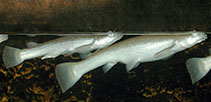| Family: |
Anablepidae (Four-eyed fishes, onesided livebearers & white-eye), subfamily: Anablepinae |
| Max. size: |
30 cm TL (male/unsexed); max.weight: 400.0 g |
| Environment: |
demersal; freshwater; brackish, non-migratory |
| Distribution: |
South America: Trinidad and Venezuela to the Amazon delta in Brazil. |
| Diagnosis: |
Eye divided into aerial and aquatic parts. Fewer than 80 scales in row above lateral line (Ref. 26938). |
| Biology: |
Mainly found in freshwater, sometimes in brackish parts of lagoons and mangrove coastlines (Ref. 26938). Moves in schools (Ref. 26938). Feeds on insects (Ref. 7020), other invertebrates and diatoms living on the mud, and small fishes (Ref. 35237). Can remain on mud bottom exposed to air during low tide (Ref. 26938). Used in eye research (Ref. 4537). Often travels in schools (Ref. 26938). |
| IUCN Red List Status: |
Least Concern (LC); Date assessed: 10 April 2020 Ref. (130435)
|
| Threat to humans: |
harmless |
Source and more info: www.fishbase.org. For personal, classroom, and other internal use only. Not for publication.
